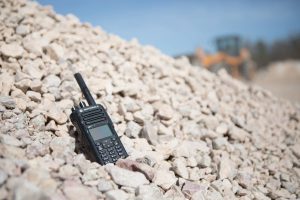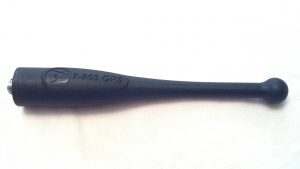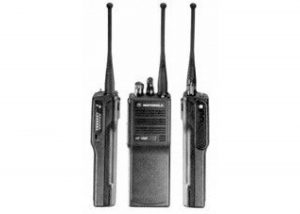If your mobile or portable radios need a tune-up, Contact Us.
Two-way radios are built to take a lot of punishment, and if you work in Alberta’s heavy industries, you’ll be putting them to the test. That shouldn’t come as a surprise. The radios face the same conditions your team works in.
There are several signs that a two-way radio needs to be pulled out of rotation and sent in for repair. Here a few that we recommend you keep an eye out for.
It’s Filthy
A portable radio is going to get dirty, especially if you’re working outdoors (construction, oil and gas, forestry, mining, etc.). Using gear with the right Ingress Protection Ratings for your environment is an excellent first step to protecting the internal components. That said, the dirt, dust, mud, and gravel that get caked into the radio and support accessories can still impact performance.
Once that debris starts getting caked into the grill of your radio or speaker mic, it can make radio calls harder (or even impossible) to hear. Depending on the radio, this same debris can also build up in and around the port you use to connect your accessories (speaker mics, headsets, etc.). If there’s too much buildup there, it can impact your radio’s performance.
Regular cleaning is the best way to prevent this from becoming a real issue. And, it’s something Tridon’s technicians will handle when you bring your radios in for service.
There Are Metal Filings in The Speaker Grill
When your radio appears to be fairly clean, metal filings are a problem you can easily overlook. If you work in a machine shop, or anywhere metal filings are commonly present, be aware that those filings can get pulled into your radio’s speaker grill. This is because there are magnetic components in your radio.
The good news is that there is a piece of felt that stops metal filings and other debris from entering the radio’s speaker. The bad news is that the buildup of debris can seriously impact audio quality. If left unaddressed, the felt can get worn down and some of that debris can enter the radio’s housing, causing further damage.
When metal filings start building up in your handheld radio’s speaker grill, the grill will look kind of hairy or fuzzy. If you see that, bring it into Tridon for maintenance.
Its Antenna is Starting to Crack
The antenna is usually the first part of a portable radio to get damaged. It protrudes out from the rest of the radio, meaning it can be the first thing to hit the ground, Radio users sometimes bend or fold the antenna without realizing that they’re doing damage to it.
Your two-way radios are tough, but the wear and tear can add up. Cracks and tears in an antenna can lead to difficulties in sending and receiving clear signals. If you notice any, it’s time for a replacement part.
A quick side note: it’s also a good idea to keep your antennas free of paint and tape. They can cover up cracks and tears that exist, making it harder for you to know when a problem is there.
You’re Having Range Issues
There are several problems that could lead to your team having range issues with their two-way radios, but the end result is the same: poor communication and a general sense of frustration.
For example, the battery or power amplifier could be underperforming. When this happens, your radio can’t draw the power it needs, meaning you can’t transmit a signal as far as before.
The antenna can be a source of the problem, as well. A common (bad) habit of radio users across industries is picking up radios by the antenna or bending and folding them. Doing that, combined with all the times a radio gets dropped on the antenna or caught on corners, can actually damage the component’s physical connection to the radio. As the damage mounts, you will experience issues transmitting and receiving.
It’s also worth remembering that two-way radios transmit signals in a straight line (line of sight). In many environments, the terrain can change to the point that it creates a new source of interference. If you’re using radios in downtown Edmonton, the construction of new office or condo towers can interfere with your signal. If you’re working in the Oil Sands, a new hill of dirt and gravel (or a new valley) can appear in a matter of days. Those terrain changes can actually lead to interference.
So, if you start experiencing range issues on site, Contact Us. It may take a bit of troubleshooting to figure out what the problem is, but there’s a solution for it.
The Battery Drains More Quickly
Your two-way radio batteries have a shelf life, and it’s usually about three years. Once a battery passes its best-before date, you may notice that it drains faster than it used to, maybe even to the point of needing recharging before the end of a shift.
You can double-check your battery’s expiry date by looking at the date code on the label (this is how Motorola labels its IMPRES batteries). If you’re getting close to the expiry date, start budgeting for replacements.
Cracks, Frays, and Moisture
Your radio is tough, but enough wear and tear can leave it with some pretty significant damage. Cracks in the housing can show up, making it easier for dirt and moisture to get in. If that happens, the internal components could get damaged, too.
Moisture (or condensation) on the inside of the screen is a sign that there is a crack in the housing, maybe even near the screen itself. If you see anything like this, along with frayed mic or accessory cords, your equipment needs repair, and possibly even replacement.
The Radio is Approaching (or Past) the End of Its Shelf-Life
Getting replacement parts for your radio while it’s still being supported by the manufacturer is no problem. Getting parts for your radio AFTER the manufacturer stops supporting them can border on impossible. The provider you went to for radios in the first place will eventually run out of their own inventory of spare parts, and you could find yourself left with a fleet of two-way radios that’s only partially functional.
There are ways to plan for this. Keep in regular contact with your radio provider so you know when your equipment is reaching the end of its supported life. If you know what that cut-off date is, you can act accordingly. One option would be to bring all of your radios in for inspection and get repaired what needs repairing. This could extend the useful life of your equipment. Or you may decide it’s time for an upgrade to newer two-way radios that will be supported for years into the future. A cost-benefit analysis will determine which way you go.
Whatever decision you make, when your radio approaches the end of its supported life, it’s time to make some decisions regarding maintenance.
You’re Gearing Up for A Busy Season
a reliable means of two-way communication. If the radios you use are in poor condition, they may end up failing you in the field. If that happens, you could end up facing significant downtime (even if it’s only a couple of radios).
Best case scenario, progress slows down because you have team members without a reliable means of communication. Worst case scenario, work grinds to a halt for hours, or even a couple of days, while you work to source and program replacements.
The last position you want to be in is scrambling for solutions to avoidable problems so you can get back to work. If you’ve been there, you know it. That’s why we encourage our clients to schedule regular maintenance for their fleet of two-way radios or, at the very least, to bring them in for a tune-up before a project starts.
Getting Started
There are signs we didn’t get to in detail, like corrosion on battery terminals and out of date firmware. Simply put, there are several telltale signs that your radios need some maintenance. Keeping an eye out for them could save you many headaches (and potentially, a lot of money and unnecessary downtime) if you get ahead of them.
So, if your radios are showing any of these signs, or if you have a project coming up, Contact Us. Our Service Technicians and Account Managers will work with you to get your equipment back to performing at optimal levels.
Tridon is a full solution Telecom Systems Integrator with CSA certification and licensed by APEGA. Our Engineering, Service and Tower Divisions collaborate with customers to build engineered solutions including communications systems design, tower inspections, and co-location, wireless broadband, fiber optic cabling, site security, and two-way radio communication.







